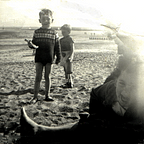Dickens Survives Train Disaster
Carriage hangs off a bridge over a ravine
On 9 June, 1865, fifty-three-year old Charles Dickens was returning to London from a trip to Paris. After crossing on the night ferry, he then caught the daily boat train from Folkestone. Sharing his first-class carriage were his mistress Ellen Ternan and her mother.
As the train crossed the Kent countryside, a team of railway workers were carrying out track repairs on a viaduct across the River Beult near Staplehurst. These were almost complete when foreman Henry Benge made a fatal mistake. Misreading the timetable, and believing that the boat train was not due for several hours, he took his men away the location
Only a single lookout, with a red flag, was left behind to warn oncoming traffic of the hazard ahead. An inquest later found that this lookout was stationed far too close to the a 20 metre gap in the tracks.
The boat train left Folkestone at 2:36 pm, with the driver unaware of any danger. Approaching Staplehurst at full speed, he saw the red flag and applied the emergency brakes but it was too late.
The train was still travelling at 30 miles per hour (48 km/h) entering the viaduct at 3:13 pm.. The engine and the front carriages managed to cross the gap but the rest. But the coaches in the center and the rear of the train fell into the river bed below.
Witnesses described the derailment as “two terrible jolts and in an instant … all became darkness … and chaos”.
The Dickens party were extremely fortunate. They were in the only first first-class coach not to plunge into the ravine. Their carriage hung off the bridge at a steep angle.
Dickens and Mrs. Ternan were uninjured. Ellen had only minor injuries. Others were not as fortunate. Ten people were killed and around forty seriously injured.
After helping the Ternans from the coach Dicken retrieved his top hat and a flask of brandy from the train and joined the rescue operation. Filling the hat with water, he then spent three hours helping the rescuers aid and comfort his injured fellow passengers.
Late into the evening, Dickens remembered he had left a very important item of luggage behind. He made his way back into the wrecked train one last time to retrieve the latest installment of Our Mutual Friend.
Dickens appeared to walk away from the crash unscathed, impressing the public with his cat-like capacity to bounce back from calamity. The only physical impact was losing his voice for two weeks in the immediate aftermath.
The psychological scars of the ‘terribly destructive accident’ ran much deeper. The postscript of Our Mutual Friend, published two months later, explicitly acknowledges trauma of his near-death experience.
I remember with devout thankfulness that I can never be nearer parting company with my readers for ever than I was then, until there shall be written against my life, the two words with which I have this day closed this book: — THE END.
The following year he wrote his classic ghost story The Signalman in which the accident is reenacted. The eponymous signalman is haunted by a nightmare in which a train driver fails to heed his red flag.
A life-long train lover, Dickens became prone sudden feelings of anxiety when traveling on them. According to his son ‘he never fully recovered’ and avoided rail journeys whenever possible.
Charles Dickens died five years to the day after Staplehurst rail crash.
